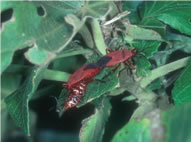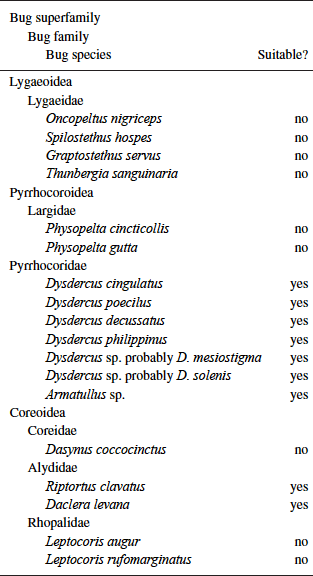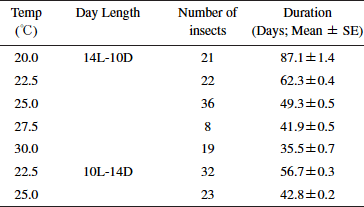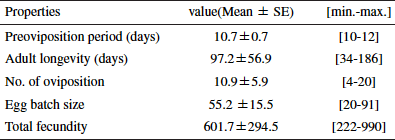Ecological characteristics of Antilochus coqueberti, a specialist natural predator of cotton stainers
Description
[Objectives]
Cotton stainers (Dysdercus spp.; Heteroptera: Pyrrhocoridae) are one of the major insect pests of cotton plants. They are difficult to control by insecticide application in cotton fields because they are highly mobile and have many alternative host plants. A pyrrhocoid bug Antilochus coquebert (Heteroptera: Pyrrhocoridae) was presupposed to prey upon cotton stainers, but there had been no precise study on its ecological characteristics. In this study, the food preferences and ecological characteristics of A. coqueberti were investigated in order to elucidate its validity as a biological control agent against cotton stainers.
[Results]
Antilochus coqueberti adults and nymphs prey upon two species of cotton stainers (D. cingulatus and D. decussatus) in the fields of Ishigaki-jima Island (Fig. 1). Laboratory experiments showed that A. coqueberti also preys upon all the pyrrhocorids and alydids; however, lygaeids, largids, coreids, and rhoparids are not preyed upon by A. coqueberti, although all of these species bear considerable visual resemblance to cotton stainers (Table 1).
Developmental periods from oviposition to adult emergence of A. coqueberti fed with D. cingulatus under each environmental condition are shown in Table 2. Based on these values, developmental zero and the effective cumulative temperature from oviposition to adult emergence were estimated to be 12.8℃ and 606.1 day degrees, respectively.
Reproductive traits of female A. coqueberti are shown in Table 3. These values clearly reflect the high reproductive potential of this species.
Female A. coqueberti did not exhibit reproductive diapause even if they were reared under short day lengths (10L-14D). The nymphal developmental period and preovipositional period were shorter when compared to those under long day lengths (Table 2).
The results detailed above show that, as a specialist natural predator, A. coqueberti is a promising biological control agent against cotton stainers, and its utilization should be highly recommended when this species is artificially reared.
Figure, table
-
Fig. 1. Antilochus coqueberti in copulation preying on Dysdercus cingulatus. -
Table 1. Suitability of bug species as prey of Antilochus coqueberti.
-
Table 2. Developmental periods from oviposition to adult emergence of Antilochus coqueberti fed with Dysdercus cingulatus.
-
Table 3. Reproductive traits of Antilochus coqueberti fed with Dysdercus cingulatus under 14L-10D at 25℃.
- Affiliation
-
Japan International Research Center for Agricultural Sciences Okinawa Subtropical Station
- Classification
-
Technical A
- Term of research
-
FY2001 (FY1999-2001)
- Responsible researcher
-
KOHNO Katsuyuki ( Okinawa Subtropical Station )
TAKAHASHI Keiichi ( Okinawa Subtropical Station )
- ほか
- Publication, etc.
-
K. Kohno, K. Takahashi and M. Sakakibara (2002):New pre-predator association in aposematic pyrrhocorid bugs: Antilochus coqueberti as a specialist predator on Dysdercus species. Entomological Science, 5 (4) (in press).
- Japanese PDF
-
2001_25_A3_ja.pdf981.12 KB
- English PDF
-
2001_22_A4_en.pdf73.11 KB




